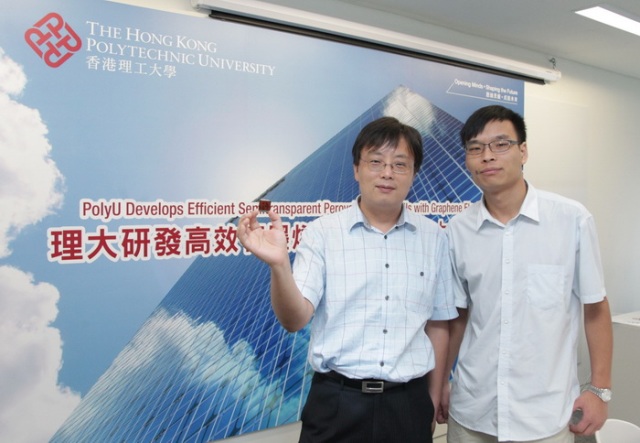Researchers from the Department of Applied Physics at Hong Kong Polytechnic University (PolyU) have created efficient yet inexpensive semitransparent perovskite solar cells using graphene electrodes.
 Dr. Yan Feng (left) of AP invented efficient and low-cost semitransparent perovskite solar cells with graphene electrodes, the cost can be reduced more than 50% compared with the existing silicon solar cells.
Dr. Yan Feng (left) of AP invented efficient and low-cost semitransparent perovskite solar cells with graphene electrodes, the cost can be reduced more than 50% compared with the existing silicon solar cells.
The growing demand for building integrated photovoltaics (BIPVs) units drives the necessity to fabricate high-efficiency, low-cost semitransparent or transparent solar cells as an alternative to the opaque and high-cost silicon-based solar panels currently being used.
Compared with the 7% power conversion efficiencies (PCEs) of traditional semitransparent solar cells, the PolyU perovskite solar cells show PCEs of about 12% when illuminated by graphene top electrodes or fluorine-doped tin oxide bottom electrodes (FTO). The cost of the new invention could be below HK $0.5 per Watt, which is below half the cost of silicon solar cells, and therefore, will be widely accepted in the days to come.
Through the photovoltaic effect, solar cells can generate electricity directly from solar energy, which is a key source of renewable energy. Although very stable, with excellent conversion efficiency, the first generation of crystalline silicon solar panels proved to be costly and opaque.
The second generation solar cells, referred to as thin film solar cells, are flexible and light weight, but were fabricated with complex structures using rare materials, followed by high temperature treatments.
Scientists have now moved onto researching third generation solar cells, which are easy to fabricate, inexpensive, and have high PCEs. Perovskite solar cells are third generation solar cells with superior power conversion efficiency.
The PolyU team created the first ever semitransparent perovskite solar cells using electrodes made from graphene so as to meet the above mentioned criteria of fabrication, pricing and efficiency.
The reasons for choosing graphene to make the transparent electrodes include its superior conductivity, high transparency and relatively minimal cost. The solar cell’s semi-transparency allows the light to be absorbed from both sides, thereby extending the surface area for absorbing solar energy at a greater level. Additionally, the design also enables the solar cell to be used in rooftops, windows, louvers and facades of buildings for producing electricity from solar energy.
Although graphene was discovered a decade ago, PolyU researchers were the first to develop simple processing methods to optimize the conductivity of the advanced material so as to meet the application requirements relating to solar cells.
Graphene’s conductivity was enhanced by coating a thin layer of conductive polymer poly-(3, 4-ethylenedioxythiophene): poly (styrenesulfonate) (PEDOT: PSS), and during the lamination process, this acted as an adhesion layer to the perovskite active layer.
The next step involved enhancing the effectiveness of power conversion. The team used multilayer chemical vapor deposition graphene as top transparent electrodes in the solar cell. This further decreased the electrode’s sheet resistance, and maintained the high level of transparency of the electrodes.
As a final step, the researchers further enhanced the solar cells by bettering the contact between the hole transport layer (spiro-OMeTAD) on the perovskite films and the top graphene electrodes.
With the simplified manufacturing process and the flexibility of graphene, it is very possible to produce semitransparent perovskite solar cells on a large scale with roll-to-roll or printing methods. Thus, these semitransparent solar cells can easily be the solution for the unresolved issues faced by the solar cells currently in the market.
The research results have appeared in Advanced Materials.